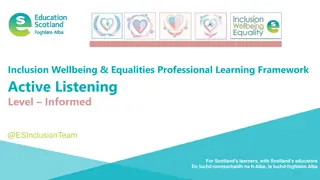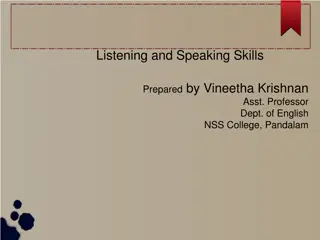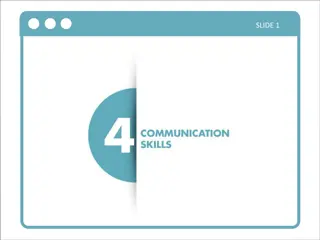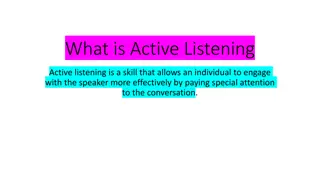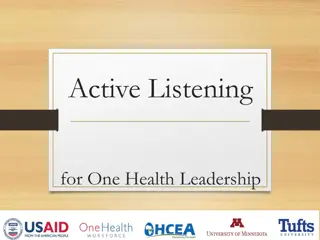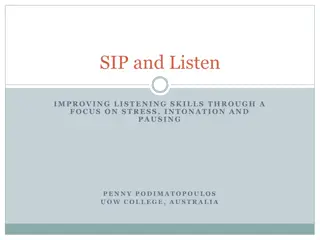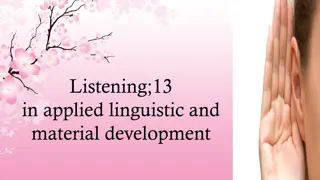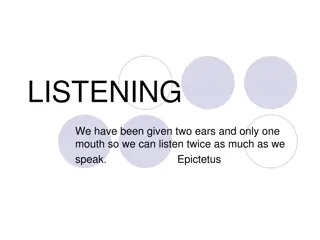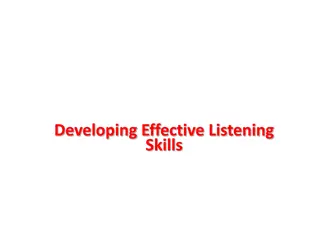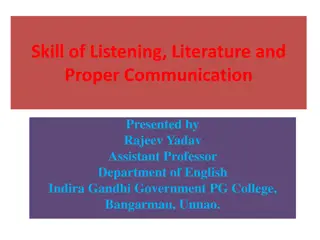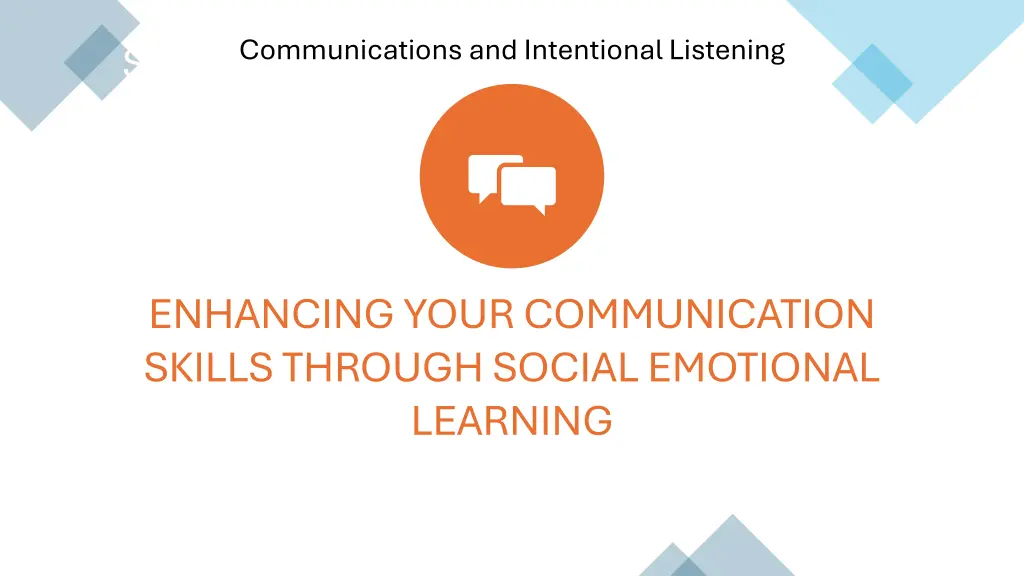
Enhance Communication Skills with Social-Emotional Learning
Explore principles of effective verbal communication and active listening through social-emotional learning. Understand the importance of communication in various contexts and learn how to apply SEL in real-life scenarios to improve team dynamics and conflict resolution.
Download Presentation

Please find below an Image/Link to download the presentation.
The content on the website is provided AS IS for your information and personal use only. It may not be sold, licensed, or shared on other websites without obtaining consent from the author. If you encounter any issues during the download, it is possible that the publisher has removed the file from their server.
You are allowed to download the files provided on this website for personal or commercial use, subject to the condition that they are used lawfully. All files are the property of their respective owners.
The content on the website is provided AS IS for your information and personal use only. It may not be sold, licensed, or shared on other websites without obtaining consent from the author.
E N D
Presentation Transcript
Communications and Intentional Listening Slide 1: Title Slide ENHANCING YOUR COMMUNICATION SKILLS THROUGH SOCIAL EMOTIONAL LEARNING
Welcome and Introductions
What You Will Learn Today Identify and apply principles of Identify and apply principles of effective verbal communication effective verbal communication. Practice active empathetic Practice active empathetic listening skills listening skills. Reflect on the impact of digital Reflect on the impact of digital devices on interpersonal devices on interpersonal communication communication. Learning Objectives
The Importance of Communication Communication: A Foundational Skill Communication is typically the highest in typically the highest in- - demand skill for leadership positions at all demand skill for leadership positions at all levels levels. Relevance of effective communication in various contexts Leadership Customer Service Collaboration Professional Success Conflict Resolution Personal Growth
Exploring Effective Verbal Communication Principles of Effective Verbal Communication via Social Emotional Learning (SEL) Empathy and Active Listening Self-Awareness and Self-Management Relationship Skills Responsible Decision-Making Clarity and Conciseness Non-Verbal Communication Awareness How SEL Enhances Verbal Communication It fosters a more compassionate and understanding communication environment. It helps prevent and resolve conflicts by addressing the emotional roots of disagreements. It promotes stronger and more meaningful connections with others.
Break out into groups and apply SEL to the Break out into groups and apply SEL to the following scenario following scenario Scenario: The Branch Transformation Project Scenario: The Branch Transformation Project Setting: Setting: A team at a regional bank is implementing a new customer service technology across all branches. The team consists of: Manager, Lisa: Manager, Lisa: Driven and results-oriented, but sometimes perceived as abrupt. Tech Specialist, Ben: Tech Specialist, Ben: Detail-oriented and analytical, but hesitant to voice concerns. Customer Service Rep, Maria: Customer Service Rep, Maria: Experienced and empathetic, but feeling overwhelmed by the change. Project Coordinator, Kevin: Project Coordinator, Kevin: Task-focused and efficient, but sometimes misses subtle social cues. Challenge: Challenge: Lisa, under pressure to meet deadlines, is pushing the team hard. Ben is struggling with technical issues but is afraid to raise them, fearing Lisa's reaction. Maria is concerned about the impact of the new tech on customer interactions but feels her concerns are being dismissed. This has led to tension, miscommunication, and a decline in team morale. How can Lisa better communicate with her team? Activity: Verbal Communication
The Power of Active Empathetic Listening Paying full attention to the speaker, understanding their perspective, and acknowledging their feelings.
Characteristics of Active Empathetic Listening Non-Judgmental Attitude Active Attention Focus on Feelings and Facts Reflection and Paraphrasing Non-Verbal Communication Providing Space and Patience Genuine Understanding Emotional Awareness
Practice Active Empathetic Listening Identify one tactic to increase your one tactic to increase your listening potential listening potential before the activity, and then strive to put it into practice Pair Up Choose a Topic Speaker Talks Listener Paraphrases Speaker Confirms/Clarifies Listener Reflects Emotion Speaker Confirms/Clarifies Emotion Switch Roles Debrief as a class
Identifying Communication Barriers Roadblocks to Effective Communication Psychological Barriers Emotional Barriers Physical Barriers Language Barriers Perceptual Barriers Attitudinal Barriers Cultural Barriers Information Overload Assumptions and Biases Poor Listening Skills Lack of Attention Conflicting Messages Technological Barriers Lack of Feedback Time Constraints
The Impact of Digital Devices A more mindful approach The good The bad Pre-Conversation Prep Shared Content Connection Between Meetings Distraction Interruption Missed Cues Decreased Empathy Phubbing Altered Skills Usage Phone-Free Zones Notifications Active Listening Communicate Needs Model Good Behavior Prioritize
Enhancing Communication for Better Outcomes How can improving your How can improving your communication enhance your communication enhance your customer service and collaborative customer service and collaborative interactions? interactions? I. Improved Customer Service: Clearer Understanding of Needs Faster Problem Resolution Increased Customer Satisfaction Enhanced Customer Loyalty Positive Brand Perception II. Enhanced Collaborative Interactions: Reduced Misunderstandings Increased Team Efficiency Improved Conflict Resolution Stronger Team Relationships Better Information Sharing
Seeking Feedback for Growth Identifies Blind Spots Identifies Blind Spots External Perspective External Perspective Specific Guidance Specific Guidance Motivates Improvement Motivates Improvement Builds Self Builds Self- -Awareness Creates a Culture of Learning Creates a Culture of Learning Awareness
Identifying Feedback Sources Who Can Provide Honest Feedback? Take two minutes to write down a list of names, positions, roles, etc. Classroom conversation based on your notes
Conclusion and Key Takeaways Effective communication is a crucial leadership Effective communication is a crucial leadership skill skill and is highly relevant for overall professional and personal relationships Identifying effective verbal communication Identifying effective verbal communication principles and practicing active empathetic principles and practicing active empathetic listening listening are core core skills Reflecting on barriers to communication and Reflecting on barriers to communication and the impact of digital devices on interpersonal the impact of digital devices on interpersonal interactions interactions is essential Improving communication skills leads to enhanced customer service and collaboration enhanced customer service and collaboration, contributing to positive outcomes in various contexts Seeking feedback and implementing tactics to improve listening potential improve listening potential are important actionable steps for communication growth tactics to
Thank You and Questions

